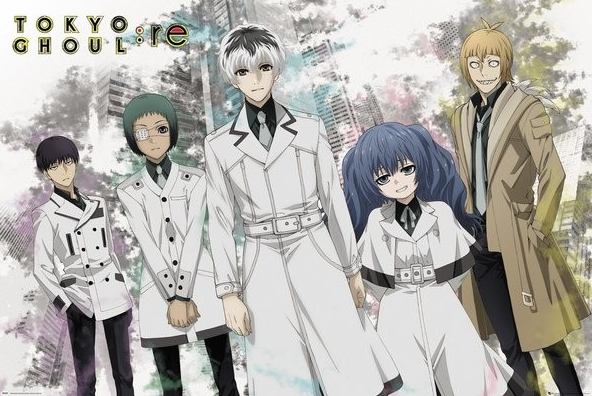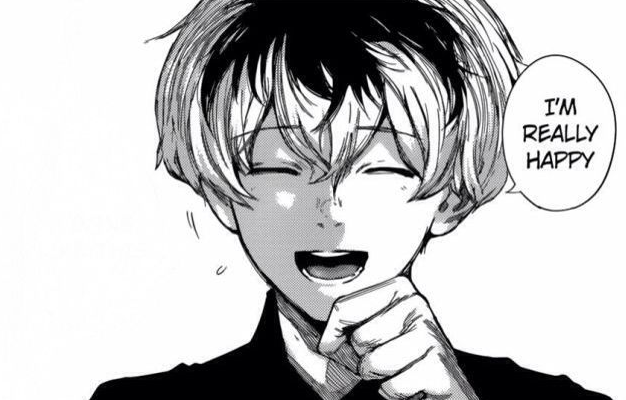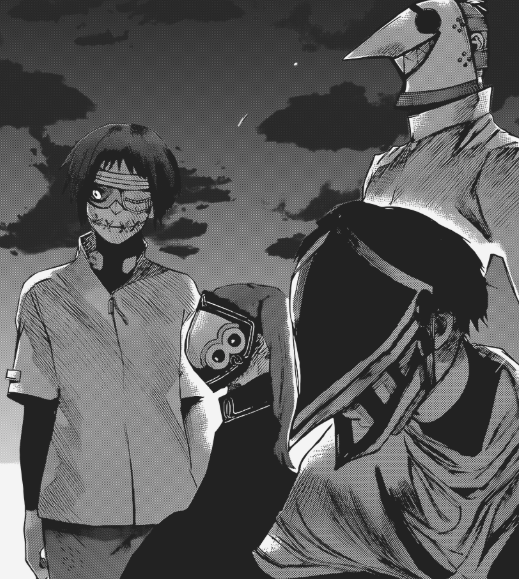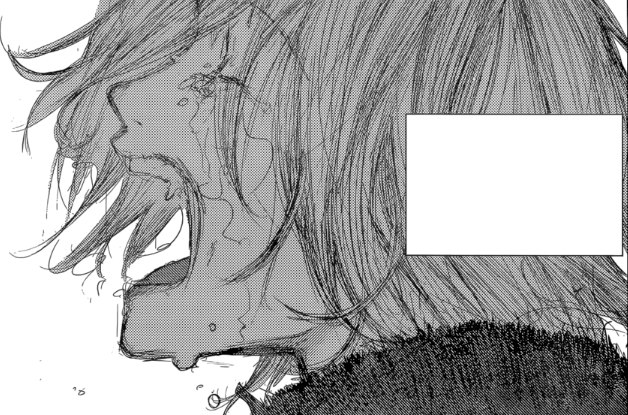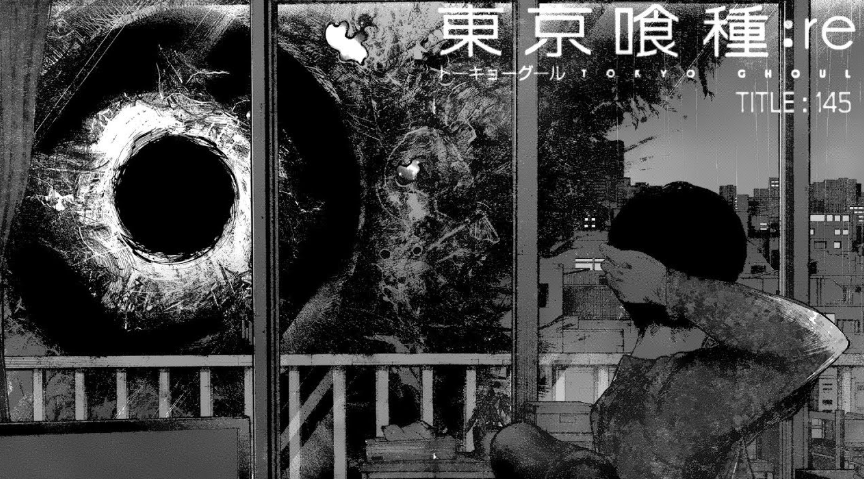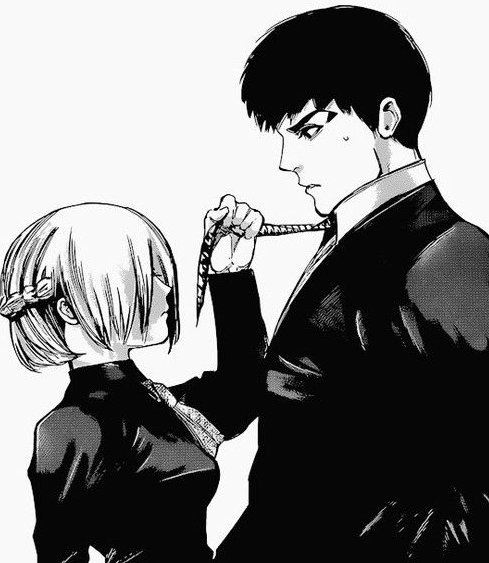Thoughts on... Tokyo Ghoul:re - Manga Review (Spoilers)
Da Squad
I finished and wrote about Tokyo Ghoul in February, but due to the delay in chapter releases on the Shonen Jump app, I was left to wait (rather impatiently) for Tokyo Ghoul:re to be uploaded in its entirety this month. I’m trying my best to divest from scanlation sites, mostly reading from official sources and buying tankobon once available, so it took much self-control to wait for these chapters, but I’m glad I did. Two days later, and I had completed the full story. Just from the start, I’ll say that Tokyo Ghoul:re is excellent, in many ways it surpasses the first half of the story.
Part one ends with a bizarre cliffhanger: Ken Kaneki is no more after his battle with Arima. The details of their battle is unknown, but it resulted in Kaneki losing his memories and assuming the new identity of Haise Sasaki, CCG investigator and leader of his own elite task force. The organisation utilises ghoul technology now, realised in Sasaki’s squad made entirely from Quinxes: humans implanted with kakuho, the organ responsible for ghoul powers. Sasaki, who is in fact a one-eyed ghoul and therefore a more advanced version of a Quinx himself, is left to mentor his team and lead out in dangerous anti-ghoul tasks.
Fake Smiles FTW
CCG personnel successfully maintain a facade around Sasaki, shielding him from all details of his previous life, leading to a highly surveilled and restricted work environment, one that slowly begins to eat away at his psyche until the moment when he finally regains his old self. The first few chapters reveals the darker undertones to Sasaki’s CCG life. He loses control of himself during a difficult investigation, submitting to the Centipede that lies dormant within his subconscious, and all senior investigators swiftly move to subdue him, labelling him as an SS-class Ghoul, much to the surprise and horror of his devoted team. This moment stands to identify Sasaki as The Other in the CCG, and the underlying fear that the rest of his colleagues hold towards him contributes to the eventual re-awakening of his former self.
Uh-oh
The story follows Kaneki’s slow resurrection through the innocent and conflicted Haise Saski, his Quinx team and their trials of identity, and Kaneki’s meteoric rise through ghoul society to become the One-Eyed King, assuming a mantel that was prepared and orchestrated for him by none other than Arima and Eto Yoshimura. A lot happens within 179 chapters but the story rarely feels rushed, although there are times when plot elements are underdeveloped or character motives become muddled in the wider, highly complicated story. Deaths abound, betrayals unravel in abundance, stilted alliances are formed, and the characters endure hardships, romance, and unrequited love. All in all, it makes for a solid story.
First of all, I like that Sasaki’s existence doesn’t last for too long. After the initial intrigue of Kaneki’s new identity, I worried that I would tire of Sasaki’s tortured innocence, but Ishida re-awakened Kaneki just before Sasaki became tedious. The artwork is just phenomenal and Ishida pushed himself with every new chapter, creating breathtaking battle scenes that were miles better than some of the confusing sequences in Part One. I especially like how Ishida uses the contrast of black and white space to denote internal turmoil: the page of Kaneki’s return is frightening, with his pale white stare penetrating through fractured black panels, and you worry for his mental health when turning to the next page, wondering if he will be the shy, reserved Kaneki from before, or a totally new, further contaminated creature.
*screams*
The theme of bonds is common in literature, and I’m always interested to see how authors decide to explore something that is innate to us, so ubiquitous in this life, and the cause of so much heartache and joy all at the same time. The bonds between Kaneki’s various allies are shown to be both a blessing and a burden. As Sasaki, he endures the strain of trying to find his own sense of self whilst caring for a team that nurses the bruises of grief, bereavement, abuse, and feelings of worthlessness from their pasts. As Kaneki the ghoul, he faces the loss of his best friend and confidant, Hide, as well as trying to bridge the endless space between his old life and his new fugitive existence away from the colleagues he once admired. As the One-Eyed King, Kaneki shoulders the fear of Tokyo’s ghoul population, pushing himself to breaking point to protect them from an increasingly toxic and hateful CCG. His need to do everything and to be everything for everyone has a detrimental affect on his health. His motives are expertly deconstructed in a conversation between himself and Rize, and he is forced to acknowledge that whilst he cares for the ghouls and his loved ones, there is an underlying selfishness of wanting to feel needed that drives him to go so far.
You can’t deny Sasaki’s boys have style.
My favourite bond is that between Kaneki and Touka. When Sasaki still roamed the streets, Touka only watched on helplessly, not wanting to trigger his old memories. Her love for him is self-sacrificing. It is clear she wants him to return to his old life and to her, but his new life has brought a newfound peace that she is reluctant to disturb. When he does return, they fully acknowledge their feelings for each other, have sex in what is the cutest and most realistic first-time sex scene I’ve read in a long time, get married, and eventually get pregnant. Once again, Touka sacrifices her personal happiness, forcing herself to digest human food all for the sake of the growing baby, and deciding to push aside the impending execution date of her best friend from school so as not to worry Kaneki and the other ghouls. Their relationship inspires their surrounding friends to fight for the survival of the ghouls, so that the future where they can exist in peace is realised in the next generation, of which Kaneki and Touka’s child is just the start.
A WEDDING! I love a wedding, me.
My second favourite almost drove me to tears during the epilogue. Maverick CCG investigator Juzo of the troubled past finally understood what it meant to have a loving parent at the end of Part One, where the admirable Shinohara is mortally wounded for his sake during the fight against the Owl. His injuries leave him in a vegetative state, and Juzo has been fighting hard, using his CCG salary to pay for Shinohara’s hospital treatment, all the while hoping that he will eventually regain consciousness. Thanks to Shinohara’s sacrificing love, Juzo begins to form bonds with his own task force, slowly learning empathy and what it means to care for others. His team’s unfailing loyalty to their boss is wonderful to see, especially during the Auction battle, when Juzo is confronted by Big Madame, his former ghoul “mother” and long-time abuser. The team steps into help Juzo, literally covering his ears so that he doesn’t have to hear the abusive insults she throws at him. At the end of the story, thanks to new ghoul technology, Shinohara awakes, and we are treated to a double page of Juzo’s tearful breakdown: the first time we see him showing true, open emotions in the whole story.
An awesome callback to Part One when Touka bites Kaneki to regain her strength. This time, he bites her as a mark of their love.
Complicated bonds are explored within Sasaki’s Quinx Squad. An initially generic one-sided rivalry develops between Sasaki and Kuki Urie, the very typical black haired, undercut-wearing, dark eye-liner- having, mean-mugging boy genius, who wants to be like Sasaki so that he can undertake missions alone and avenge his father. I’m happy to report that after Sasaki changes back to Kaneki and leaves the CCG, Urie is forced to be a mentor and friend to the remaining Quinx Squad, becoming a solid leader and responsible investigator, standing against Furuta’s new sadistic CCG and choosing his own method of justice. His new resolve is triggered by the death of the comical Ginshi Shirazu, who dies in Urie’s arms, and after which Urie is forced to admit that without loyal teammates, he is nothing. Urie’s transformation into a well-rounded character of depth is just one of many instances where apparently generic shonen-type archetypes are given a sophisticated progression, quickly lining up for a Best Boy prize.
JUZOOOO
In a weird contrast is the fragile Toru Mutsuki, whose unhealthy obsession with Kaneki drives him to a madness which is first noticed by Urie. He slowly deteriorates, becoming a much stronger Quinx than the others, leading his own teams, and unwaveringly siding with Furuta’s genocidal assault on the ghouls, all to quell a raging jealousy of Touka. For Toru, if Kaneki is hurt or wounded, or subdued well enough, he will be forced to re-join the CCG. If Toru’s plans fail, then he resolves to kill either Touka, Kaneki, or both, in a twisted “if I can’t have you, nobody can” type of way. Toru is eventually challenged and taken to task by Urie and Yonebayashi, but an inner discomfort of his previous actions remain even in the epilogue.
Besides the bonds, I think it’s important to mention the wider theme here. It was evident in Part One, where Kaneki struggles between his two worlds, trying to find a safe middle-ground for both humans and ghouls. I already explained my admiration for how Ishida explores these ideas in my review of Part One, but once again, Ishida strays away from heavy-handed preaching. He does not outwardly declare “both sides are right, both sides are wrong”, but opts for the much more nuanced “both sides are flawed”. The humans obviously live in fear of the ghouls. The ghouls live in fear of humans because they have no control over their feeding habits, and even when they have tried to assimilate into human society and adjust their diets by way of suicide hotspots for example, they have still been outed and then massacred by the CCG. Knowing that the ghouls get married, attend school, and have children, helps the reader to empathise with their complicated relationship with the human race, and in many ways they are minorities, despite having the physical upper-hand. But despite these issues, Ishida makes it clear that the ghouls are wrong for hunting humans for sport.
Urie. I didn’t like him before but I stand corrected on his character. He’s a good boy.
In Part Two, these ideas are taken further when Kichimura Furuta of the Washu clan kills his rivals and ascends to the directorship of the CCG. His tenure is identified by the introduction of the Oggai, artificial one-eyed ghouls, and a manaical rampage against the ghoul population, driving them into an underground hideout where they languish with hunger, fatigue, and fear of one day being totally wiped out. Kaneki is the king of this underground population, and is pushed to the brink whilst on a journey to source food. The hideout is raided by the Oggai in his absence. Many ghouls are killed, the pregnant Touka is mortally wounded, and Kaneki is dismembered by Juzo’s squad. In his desperation and despair, he gorges on the Oggai, morphing into a monstrous creature that destroys most of Tokyo above-ground. His descent into madness is shown in the breathtaking chapter 145. Totally without dialogue, we witness as Kaneki’s uncontrollable body slaughters innocent humans, razes buildings to the ground, and flattens entire towns. The ghouls and the CCG watch in horror, unsure of what to make of what can only be described as a monster.
Bloody hell, Kaneki.
Reading Tokyo Ghoul:re helped me understand the issues I’ve had with Attack on Titan of late. Whereas Kaneki’s fit of madness and fear drives him to become the monster and unwillingly kill innocent bystanders, Eren has actively decided to go on a genocidal rampage, opting to protect Paradis Island by sending an army of colossal titans to trample the rest of the planet. I don’t need to agree with everything a protagonist does, and I am comfortable with flawed characters, but Eren’s slow decay has been worrying to witness, and without an inner monologue to really digest his thought process, his actions just come across as overly edgy and ridiculous, especially now that his former friends and enemies have teamed up to stop him, with each character not quite knowing where they stand, how they feel about Eren, and what their plans actually are. With no clear motive for any character other than “stop Eren, even if it means we all die” and not knowing why Eren has chosen to rebel from his comrades and just do his own thing, my enjoyment of this final arc has waned.
As a character in a similar circumstance, Kaneki’s actions are much more understandable: he ate the Oggai out of a sudden desperation, no doubt thinking of Touka and his unborn child, and all the innocent ghouls who were simply living in hiding, not disturbing any humans when the CCG killed them. He then unknowingly kills countless humans in his new form, and afterwards he is taken to task for his actions by Rize, where he is forced to face the innocent lives he ended, and come to terms with the reckless and destructive method of survival he chose. At this point, because both the ghouls and Kaneki’s former CCG colleagues know that this behaviour is unlike him, they are able to put their differences aside and destroy the body of the monster, knowing that that is exactly what Kaneki would have wanted, unlike the 104th regiment who at this point don’t even know who the fuck Eren is anymore.
More lives than a cat.
The revived Hide becomes the new “bridge” between the two sides, encouraging them to think of the bigger picture, and wanting to save Kaneki from himself. When they finally free him, Kaneki does the right thing and joins the efforts to destroy the monster’s core and defeats Furuta, putting his life at risk to atone for his actions. Unlike Eren, Kaneki doesn’t verbally abuse his best friends, he doesn’t choose to run off by himself and go on a solitary mission, he doesn’t double-cross any and every side he aligns with, betraying pretty much every character’s trust (beside Floch). Attack on Titan is yet to finish, and I anticipate some more explanation of Eren’s cruel change of heart, but at this point it will take a lot of work for Isayama to convincingly sympathise Eren for me, or at least relegate him to the title of anti-hero instead of “flawed hero”, because hero he ain’t.
Before this review gets overlong, I will touch on a few things I disliked. The Sasaki/Arima relationship was a little under-cooked. In Part One, Arima is the fearsome investigator, and when he appears before Kaneki to fight him, it’s clear that Kaneki will lose. In Part Two, the pair shares some nice moments together, but they are fleeting. After Kaneki regains his consciousness, and Arima’s squad properly explain their captain’s private support for the ghouls as the true One-Eyed King, we are given a touching montage of their mentor/student relationship where it is shown how much Kaneki loved and respected Arima. I would have liked to see this in the actual narrative.
Would have loved to see more of this in the actual story, and not during flashbacks.
Secondly, the One-Eyed King, the Owl, and associates get extremely complicated at times. I always assumed that the fabled One-Eyed King was obviously Kaneki, but then it turned out that Arima was the King, with the purpose to pass on his will to Kaneki, who up to that point was just the infamous one-eyed ghoul. There are about two or three Owls running around, one of them is Eto Yoshimura, daughter of the other Owl, also known as our kindly Anteiku cafe manager, Mr Yoshimura. During the final battle against Furuta and his cronies, another Owl emerges from the mix, which turns out to be Eto again, who was completely missing from the story, even as a memory. In all this mix, the subject of Dr Kano and his involvement with the ghouls is almost forgotten about until the last few chapters, but not without leaving a significant legacy in the form of medical research which helps millions of patients, Shinohara being one of them.
I took issue with Shuu Tsukiyama’s backstory also. Considering just how influential and important the Tsukiyama family is to Japan, I thought it strange that they had not been mentioned or properly explored prior to their central arc. During the epilogue, the Tsukiyama family assists in the rebuild and reconstruction of their new world of human-ghoul co-existence, which is nice to see, but raised questions as to why they did not have a more prominent role in the fight against Furuta.
LOL but Eto, where were you before?
As a final criticism, I’m not a fan of the revived characters. When someone dies, the impact of their death really has the power to drive the story forward in a meaningful way. When that character turns out to have been alive after all, or worse, revived a la Naruto, death stops having meaning. I had to flick back a few chapters when Hide reappeared because everyone treated his re-introduction as absolutely normal, when up to this point, it is believed that he allowed Kaneki to eat him so that he could survive against Arima. We are not told how Hide returned to the land of the living, albeit drastically scarred, but he is there and without him, Kaneki would have sank Tokyo into the sea. Likewise Amon’s return took a backseat, and I once again mourned what could have been a great enemy/rival relationship between him and Kaneki. There goes my Garp/Roger theory. For most of Part Two, Amon loiters around in the background, endures a very meaningful and heartbreaking fight with the ghoul that was supposed to be his father, and then melts into the distance with Akira, never to be heard from again. I do feel his character was wasted.
Well at least they’re together
Lastly, I appreciated the epilogue. We get to see how Tokyo rebuilt itself after the war, what became of the CCG, and more importantly, we get the beginnings of a solution to the human-eating problem in the form of a government lab to develop synthetic meat for the ghouls. Take note, The Promised Neverland! I loved seeing Naki and Miza’s nine fucking kids, and the rest of Kaneki’s ghoul comrades living their best lives. However, Deathly Hallows this is not. We are shown that despite the new order of things, there are ghouls who still choose to hunt humans, which reveals the purpose of the rejigged CCG, and a darker hint is given to a new class of ghoul mutants without sentience, brought into their world by of Kaneki and Furuta’s ghoul monster. Toru maintains an amicable relationship with the rest of his old friends, but it is clear he suffers from shame and embarrassment regarding his previous actions, and whilst the rest of the Quinx squad visits Kaneki, Toru keeps his distance.
What I love about the epilogue is the Kaneki reveal. He and Touka have a young daughter and live in a house as a family. Their Anteiku friends regularly visit their home, as well as Hide and others. Kaneki undergoes many physical changes over the course of Tokyo Ghoul, oftentimes reflecting his mental state or a new identity he has had to assume for survival, but the final incarnation is a healthy mix of his King persona via the white hair, and the doe-like, innocent eyes of the Kaneki from way back at the start of the manga. I suppose the story we are being told, from that panel alone, is that Kaneki has finally found himself, no longer burdened by all the different iterations of his self that haunted him all throughout the story. He has grown into himself, which is an additional victory over the darkness that almost consumed him previously.
My HEART.
As a whole story, Tokyo Ghoul really surprised me with how good it is. I wasn’t sure what to expect when I started reading two months ago, but it has been a welcome read during these strange quarantine days, and the characters have stayed with me all week. I keep thinking about Kaneki’s resilience, and how he was able to overcome so much trauma and hardship and still emerge from it with his morals and character in tact. He is not the shy, naive bookworm from the start of the story, but he is still Kaneki, older, wiser, and a survivor of complex trauma. It is hard not to love him.
I’ll give this a 9/10.
